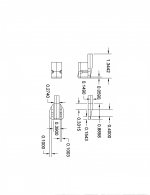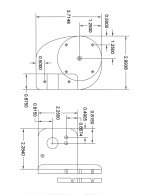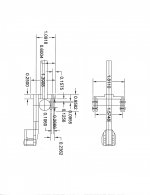Imho, the weight of this arm will cause the suspension to become unbalanced. Increasing the stiffness of the springs will tend to eliminate the intended benefits of the suspended design. However, you can consider a variety of means by which the arm and a mounting system can be made that do not connect to the original sub-suspended system. The simplest is to remove the old arm and mount on a plate on top, or mount the new arm in a different location. In the event you remove the old arm and keep the suspension, weigh the old arm and put something to equal the weight on that part of the suspended assembly...
etc...
etc...
I have ordered some carbon arrows myself today. Hopefully I will have them within the week.
I have also located a local chemist who should have pyrex glass tubes.
A fast question...
Instead of using one glass tube and 4 bearings, could it be better to use two glass tubes side by side and just two bearings that would fit in between?
Also, I understand that the outer part of bearings is not designed to be rolling, so it could have imperfections that could affect sliding. Woudln't it be a good idea to fit them inside glass rings? So that the friction point would be glass to glass?
It could be a bit tricky to properly cut the rings out of the tubes, but we could also use wider rings with a curved spacer and let their mid touch the glass tube and not their edge.
I have also located a local chemist who should have pyrex glass tubes.
A fast question...
Instead of using one glass tube and 4 bearings, could it be better to use two glass tubes side by side and just two bearings that would fit in between?
Also, I understand that the outer part of bearings is not designed to be rolling, so it could have imperfections that could affect sliding. Woudln't it be a good idea to fit them inside glass rings? So that the friction point would be glass to glass?
It could be a bit tricky to properly cut the rings out of the tubes, but we could also use wider rings with a curved spacer and let their mid touch the glass tube and not their edge.
Drawing of My Arm
Attached are the drawing made for the construction of my arm. I can make pdf's if you need for scale. I also use a 16mm heavy walled glass rod for my design. If enough want it and you have a bit of patience I can redraw with the specified 10mm tube that most people have. Easy enough to estimate for yourself though.
This arm is working like a champ with a Denon 103r. about 2gm tracking force as best as I can estimate. VERY dynamic and solid soundstage. Very clear sounding with no smearing evident.
This arm has not worked well with my Lyra Keos though. Need to play with it some more to make sure I set it up correctly.
Attached are the drawing made for the construction of my arm. I can make pdf's if you need for scale. I also use a 16mm heavy walled glass rod for my design. If enough want it and you have a bit of patience I can redraw with the specified 10mm tube that most people have. Easy enough to estimate for yourself though.
This arm is working like a champ with a Denon 103r. about 2gm tracking force as best as I can estimate. VERY dynamic and solid soundstage. Very clear sounding with no smearing evident.
This arm has not worked well with my Lyra Keos though. Need to play with it some more to make sure I set it up correctly.
Attachments
Last edited:
I have ordered some carbon arrows myself today. Hopefully I will have them within the week.
I have also located a local chemist who should have pyrex glass tubes.
A fast question...
Instead of using one glass tube and 4 bearings, could it be better to use two glass tubes side by side and just two bearings that would fit in between?
Also, I understand that the outer part of bearings is not designed to be rolling, so it could have imperfections that could affect sliding. Woudln't it be a good idea to fit them inside glass rings? So that the friction point would be glass to glass?
It could be a bit tricky to properly cut the rings out of the tubes, but we could also use wider rings with a curved spacer and let their mid touch the glass tube and not their edge.
you may just as well use one glass tube and build a Cantus that way you can help keep your bearings clean. Best regards Moray James.
LEXX21
Be careful messing with the table's set up. In my table I cannot say what the original microphonics were, but my granite block has not worked at all. The arm works great when set up right, but for me now reducing the microphony is my next upgrade. I have tried all sorts of stuff but to little success.
Be careful messing with the table's set up. In my table I cannot say what the original microphonics were, but my granite block has not worked at all. The arm works great when set up right, but for me now reducing the microphony is my next upgrade. I have tried all sorts of stuff but to little success.
you may just as well use one glass tube and build a Cantus that way you can help keep your bearings clean. Best regards Moray James.
Makes sense, but I m really not confident cutting glass...
Attached are the drawing made for the construction of my arm. I can make pdf's if you need for scale. I also use a 16mm heavy walled glass rod for my design. If enough want it and you have a bit of patience I can redraw with the specified 10mm tube that most people have. Easy enough to estimate for yourself though.
This arm is working like a champ with a Denon 103r. about 2gm tracking force as best as I can estimate. VERY dynamic and solid soundstage. Very clear sounding with no smearing evident.
This arm has not worked well with my Lyra Keos though. Need to play with it some more to make sure I set it up correctly.
Your measurements are in inches right?
Yes. Unfortunately we still havn't figured out that metric is easier here. So my shop equipment is in inches meaning that I have to make the drawing in inches.
LEXX21
Be careful messing with the table's set up. In my table I cannot say what the original microphonics were, but my granite block has not worked at all. The arm works great when set up right, but for me now reducing the microphony is my next upgrade. I have tried all sorts of stuff but to little success.
Understood. I decided last night to pick up a rek-o-kut table and build my plinth with the arm in mind. Best to the the td150 as is. I did replace the original arm with a jelco arm and it was a huge improvement. I am really itching to get a linear arm up and going.
Yes. Unfortunately we still havn't figured out that metric is easier here. So my shop equipment is in inches meaning that I have to make the drawing in inches.
Lol... right you are. I try to do everything in metric when building. It makes things SOOO much easier and SAE is just so backwards compared to metric. I just keep my caliper handy.
Makes sense, but I m really not confident cutting glass...
buy some tube and use a regular glass cutter. Google a "how to" and practice with a straight edge. buy a little diamond glass file to clean up your edges they don't cost much. you should be good to go in no time. I expect you could make your parts back in cutting tubes for those who would like someone else to get their glass and cut it for them. Good luck and best regards Moray James.
Cutting a section out of a glass tube along the long axis has got to be something of a pro level cut using a standard glass scribe... maybe there's a demo on youtoobe or similar? I'd use a diamond saw blade with a water cooling stream...
For cutting tubing to length (or bottles) my method is to scribe the outer perimeter, then apply a length of nichrome wire which is heated by a low voltage xfmr connected to a variac (for temperature control) to the scribe. Heat, and <tink> the glass self separates. Some carborundum or aluminum oxide sandpaper is usually sufficient to clean up sharp edges.
For cutting tubing to length (or bottles) my method is to scribe the outer perimeter, then apply a length of nichrome wire which is heated by a low voltage xfmr connected to a variac (for temperature control) to the scribe. Heat, and <tink> the glass self separates. Some carborundum or aluminum oxide sandpaper is usually sufficient to clean up sharp edges.
I don't believe this would be all that hard. I have a straight cutting jig( think matte cutter), used for stained glass cutting. But you certainly could make your own. At least that is how a PRO would do it. Build a jig. Cutting glass is a snap, ha, ha! Pun intended.
I would just use a cutter and jig, but if you choose to remove the gap completely, one end to the other. Maybe use string dipped in acetone, fire and cold H2O/water.
http://www.youtube.com/watch?v=_vILNflmwF
Also this would be a fantastic meathod of actually breaking the glass away. It works very effectively for novice and pro alike. Start watching at about 5:00min.
Wine Bottle Cutting 30 seconds Perfect Edge Bottle Cutter GreenPowerScience Bottleneck Guitar Slide - YouTube
I will build a jig. to hold a tube slightly under water. And, with a Dremel(rotary tool) and a 0.250" diamond impregnated bit. This will be to route out the slot. a straight and a consistent gap. I'll do it this way because the cuts wont be the length of the tube.I wish the part in the mount to be whole.
.
I would just use a cutter and jig, but if you choose to remove the gap completely, one end to the other. Maybe use string dipped in acetone, fire and cold H2O/water.
http://www.youtube.com/watch?v=_vILNflmwF
Also this would be a fantastic meathod of actually breaking the glass away. It works very effectively for novice and pro alike. Start watching at about 5:00min.
Wine Bottle Cutting 30 seconds Perfect Edge Bottle Cutter GreenPowerScience Bottleneck Guitar Slide - YouTube
I will build a jig. to hold a tube slightly under water. And, with a Dremel(rotary tool) and a 0.250" diamond impregnated bit. This will be to route out the slot. a straight and a consistent gap. I'll do it this way because the cuts wont be the length of the tube.I wish the part in the mount to be whole.
.
Also, I understand that the outer part of bearings is not designed to be rolling, so it could have imperfections that could affect sliding. Woudln't it be a good idea to fit them inside glass rings? So that the friction point would be glass to glass?
A properly finished steel bearing race against a high quality glass tube is imho about as good as we are going to get. Cutting glass rings won't give the corners anywhere near as good as stock bearings.
Last night I checked the corners of my bearing races with a good loupe and light. Was appalled at the corner condition. One of the 4 bearings was pretty smooth but the other three had poor surface finish with tool marks, rough surface, sharp corners not nicely radiused etc. These were RC car bearings, hybrid ceramic/steel. One of my clock parts suppliers recently started selling a pivot polishing system that works with a Dremel and a small lathe or horizontally held drill. It uses three different grits of carbide impregnated disks and a mandrel. The pivot, or in our case the bearing, is held in the lathe on another mandrel and spun. Then the rapidly rotating abrasive disks are presented to the corner to be polished. I found only the finer 2 of the three grits necessary. 15 to 20 seconds with each grit was all that was needed to produce a nice radius with a mirror finish. The polished bearings run so much smoother especially for the vertical sliding motion. It was also much easier to set the vertical tracking force. There is a trial kit of the 3 disks and mandrel available for the princely sum of $4.00 plus shipping. After seeing how well this works I would deem it essential for any linear tracker using ball bearings running on glass tube either inside the tube or outside. For more info contact Butterworthclocks.com. I have no connection with Butterworth other than as a customer.
BillG
Nice 🙂
Although my guess is we can do this with a plain motor assembly and some soft fine grit polishing disks most of which are available for dremel like tools too.
btw Butterworthclocks.com asks for authentication :S
Although my guess is we can do this with a plain motor assembly and some soft fine grit polishing disks most of which are available for dremel like tools too.
btw Butterworthclocks.com asks for authentication :S
Last edited:
I will build a jig. to hold a tube slightly under water. And, with a Dremel(rotary tool) and a 0.250" diamond impregnated bit. This will be to route out the slot. a straight and a consistent gap. I'll do it this way because the cuts wont be the length of the tube.I wish the part in the mount to be whole.
.
eye protection
eye protection
I'm 48. Been doing this or that, machining, remodeling etc,, for 30+yrs. All good.🙂
Bill,
I'm surprised you needed to do this to the bearings, maybe I've just been lucky with getting nice polished edges, though where I buy them I get to hand pick them one by one. I still don't see the point in ceramic, these are only out there for high rpm/high heat, the hard core rc car guys have told me friction is possibly higher with these beasts. I'd understand some polished gemstones, but for the 9mm bearings standard steel jobs are well done.
Colin
I'm surprised you needed to do this to the bearings, maybe I've just been lucky with getting nice polished edges, though where I buy them I get to hand pick them one by one. I still don't see the point in ceramic, these are only out there for high rpm/high heat, the hard core rc car guys have told me friction is possibly higher with these beasts. I'd understand some polished gemstones, but for the 9mm bearings standard steel jobs are well done.
Colin
Made a start too.
I`ve bought 4 different quads at Acer Racer, all nice edge`s.
But I c`nt find well fitting O-rings.
So for one tube I `ve used a piece of tube shrink and for the second I "filled" it with a Bee-wax look a like wax.
Any suggestions where to order the small O-rings?
Hans.
I`ve bought 4 different quads at Acer Racer, all nice edge`s.
But I c`nt find well fitting O-rings.
So for one tube I `ve used a piece of tube shrink and for the second I "filled" it with a Bee-wax look a like wax.
Any suggestions where to order the small O-rings?
Hans.
In the USA you can buy O rings from plumbing supply houses (square profile rings of rubber too!), hardware stores, and automotive supply houses. Also you can get assortments in a plastic pak. Probably you can find the assortments online too...
- Home
- Source & Line
- Analogue Source
- DIY linear tonearm



